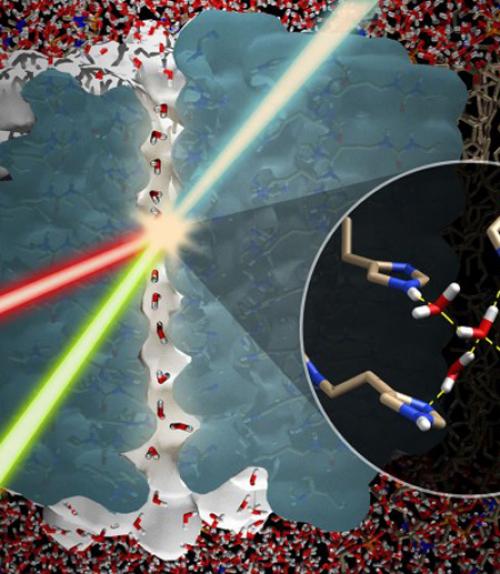Approximately 70 percent of the Earth’s surface is covered by water, but only 2.5 percent of that is fresh water, and less than half of that is easily accessible. Efficient desalination, therefore, is crucial for sustaining life now and in years to come.
But a challenge in developing bioinspired synthetic purification systems lies in deciphering the complexity of natural systems like aquaporins (AQPs), nature’s most efficient water transport system. These proteins form pores in the membranes of biological cells, facilitating highly efficient water transport.
An international research partnership – co-led by Poul Petersen, assistant professor in the Department of Chemistry and Chemical Biology – has made the first direct observation of the structure of water inside artificial water channels. Understanding the “shape of water,” so to speak, under those conditions will help inform biomimetic purification systems of the future.
Petersen is co-senior author of “Oriented Chiral Water Wires in Artificial Transmembrane Channels,” which published March 23 in Science Advances. The paper’s other senior authors are Mihail Barboiu of the Université de Montpellier, France; and Georges Belfort of Rensselaer Polytechnic Institute.
Water wires – hydrogen-bonded chains of associated water molecules, which have properties that are very different from bulk water – have been confirmed in theory for years but never actually seen. Petersen and his collaborators, through nonlinear sum-frequency vibrational spectroscopy, claim the first experimental observation of the dipolar oriented (electrically neutral) wire structure of water in nanoscale channels, including supported lipid bilayers, similar to aquaporins.
“I would call this the first real observation of a water wire,” Petersen said. “We’re not just seeing the oxygen [atoms], we see the protons, as well. It’s the first observation of the hydrogen bonding in a water wire.”
This work employs some of the methods Petersen’s lab used in work published last year, in which it reported the first observation of a chiral water superstructure surrounding a biomolecule (DNA).
“We can do our chiral method, just like we did for the DNA research, and see that they also form a chiral structure,” Petersen said. “They have a helicity to them – they sort of spiral through.”
One of the key findings: The net dipolar orientation of water molecules in confined channels induced specific polarization of the channel, which likely acts as a driving force for water permeation through the membranes.
The best current method for desalinating seawater is reverse osmosis – fluid passing through a membrane in the direction opposite of naturally occurring osmotic pressure. The group feels that identifying the chirality of water structures within these artificial channels will inspire design of more efficient purification technologies in the future.
“Scientists are trying to make structures that mimic aquaporin – that’s the gold standard for water transport,” Petersen said. “And for aquaporin, we know it’s all about the alignment of the water molecules, and their helical nature, that is important for water transport.”
Also contributing was Heather Vanselous, Ph.D. ’17, and doctoral student Stephanie Sanders, both from the Petersen group. Sample preparation included work conducted at the Cornell Center for Materials Research, which is supported through the National Science Foundation’s Materials Research Science and Engineering Centers program, as well as the Cornell NanoScale Science and Technology Facility, also supported by the NSF.
Petersen’s contributions to this work were supported by a Young Investigator grant from the Arnold and Mabel Beckman Foundation, and through his NSF Career Award grant.
This story also appeared in the Cornell Chronicle.




